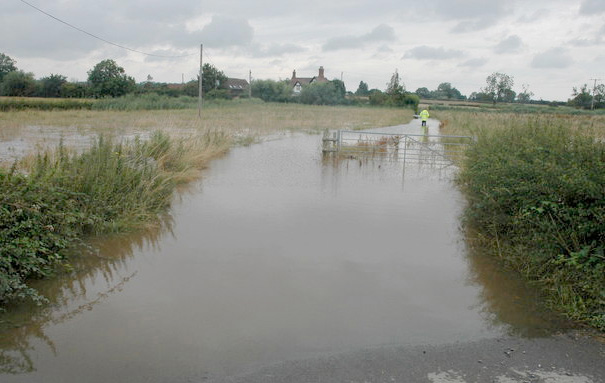
NFU Scotland has written to the Scottish Government and SEPA calling for a high level meeting to discuss watercourse management following significant flooding in parts of Scotland.
Parts of southern, south west and central England remain at risk of flooding as river levels remain high. While the overall picture is starting to improve as river levels stabilise, risks to people and property remain.
Severe flood warnings remain in place along the Thames and in Somerset where water levels continue to rise in response to recent rainfall. Ground water flooding also continues to pose a risk in some places.
The Environment Agency is working with the local authority and military to reduce the risk of flooding from the River Test in Romsey, Hampshire where there is a risk of river banks being overtopped.
Whilst Scotland has not suffered flooding to anything like the same extent as parts of England and Wales, there are many individual farmers who have experienced significant damage and losses in one of the stormiest winters in some areas of Scotland.
The Union has been receiving calls from members hit by flooding since late December 2013 and the number now affected by the high rainfall is increasing. Many of those contacting the Union feel that the rules around watercourse management and practices such as dredging are confusing, expensive and restrictive.
NFU Scotland President Nigel Miller wrote to Environment Minister Paul Wheelhouse and SEPA Chairman, David Sigsworth asking for regulations and guidance to be examined in light of problems this winter.
In the letter, Mr Miller wrote: “I have watched with dismay as farmers and rural residents in many parts of England and Wales have battled with flooding over recent weeks. Whilst Scotland has not suffered to the same extent, there are many farmers who have individually experienced significant damage and losses.
“This, coupled with a groundswell of opinion that regulation of management of watercourses is too confusing, expensive and restrictive – and is thus reducing the resilience and productivity of Scottish farming – means that I feel the time has come for a review of this issue here in Scotland.
“NFU Scotland welcomed the changes made to the Controlled Activities Regulations (CAR) in 2012/3 as a step in the right direction. This included a new registration for removal of parts of dry gravel bars, increasing the registration threshold for previously straightened watercourses from three to five metres, and the introduction of catchment licences.
“However, further change is essential if Scottish agriculture is to remain productive and viable under a changing climate. Due to years of restrictive, expensive and confusing regulation, a large number of farmers have heavily silted or gravelled watercourses, which are negatively impacting on field drainage and watercourse carrying capacity.
“This is reducing the productivity of farm land, increasing the diffuse pollution risk, and increasing Climate Change emissions.
“There are also numerous instances of damage to flood banks caused by overly restrictive regulation of management of gravel bars. Repair of these defences will be extremely expensive, and in the meantime the flood risk in the vicinity is increased.
“It is highly likely that higher rainfall and more extreme rainfall events will typify our future climate here in Scotland. NFU Scotland therefore calls on Scottish Government and SEPA to engage in discussion about how to rebalance regulation of the management of watercourses, rather than waiting for events to bring about a crisis situation that affects our members, taxpayers, and government.
“Alongside this, NFU Scotland would like to see substantive progress on implementing payments/mechanisms for farmers to do natural flood management, as progress to date on this has been disappointing.”
Mr Miller has invited interested parties to meet at their earliest convenience and agree a course of action that meets the needs of Scotland’s farmers without compromising Scotland’s environmental obligations.
Despite the improving weather, the Met Office is forecasting further rain on Monday. With the ground already saturated, rivers levels will respond quickly to further rainfall. Areas of standing water could take many weeks to drain from flooded land.
River levels on the Thames are expected to rise again over the next five days as rainwater from the recent bad weather moves downstream. These levels are not expected to exceed those already seen in recent days.
There is also a continued risk of flooding for the Somerset Moors and Levels, where levels continue to rise.
The Environment Agency continues to monitor river and ground water levels closely. Environment Agency teams are working round the clock to support local authorities’ relief effort and to inspect damage to coastal defences.
The Thames Barrier was closed today at 11am for a record eighteenth consecutive time as the Environment Agency works to protect communities along the River Thames.
The largest pumping operation ever undertaken in Somerset continues. 54 pumps are working around the clock to drain over one million tonnes of water per day.
On the coast, the threat of tidal flooding is now receding. However, the public are urged to remain away from the seafront as waves remain high.
River levels on the Severn remain high but are now falling gradually. They will increase again in response to rainfall but are not expected to cause additional flooding.
There are 16 Severe Flood Warnings including 14 for the River Thames from Old Windsor to Shepperton and two for the Somerset Levels & Moors. There are also 134 flood warnings and 186 flood alerts for England.
Since the 1st January 2014, the Environment Agency has sent over two and a half million flood warning messages to the people with properties at risk of flooding.
